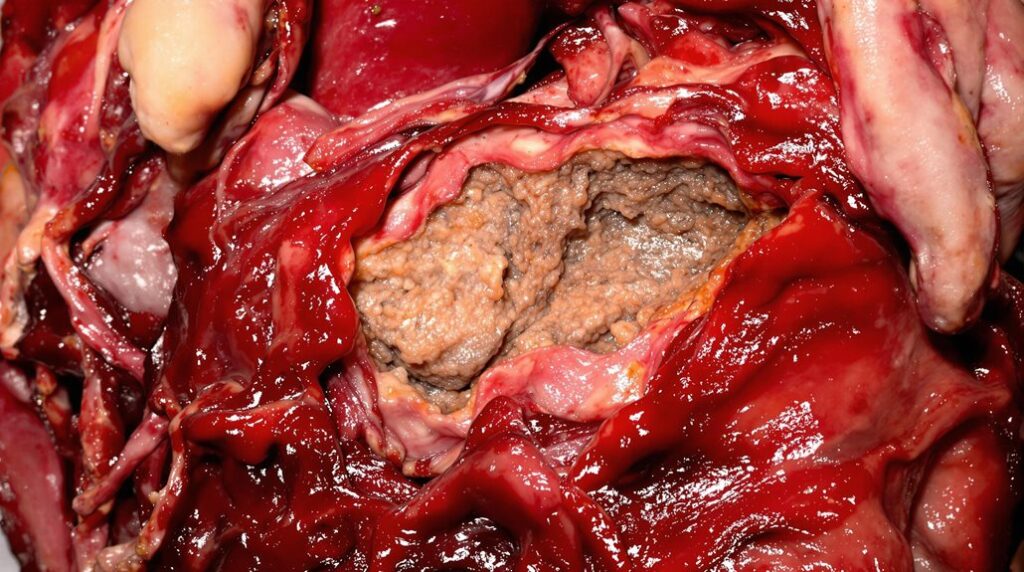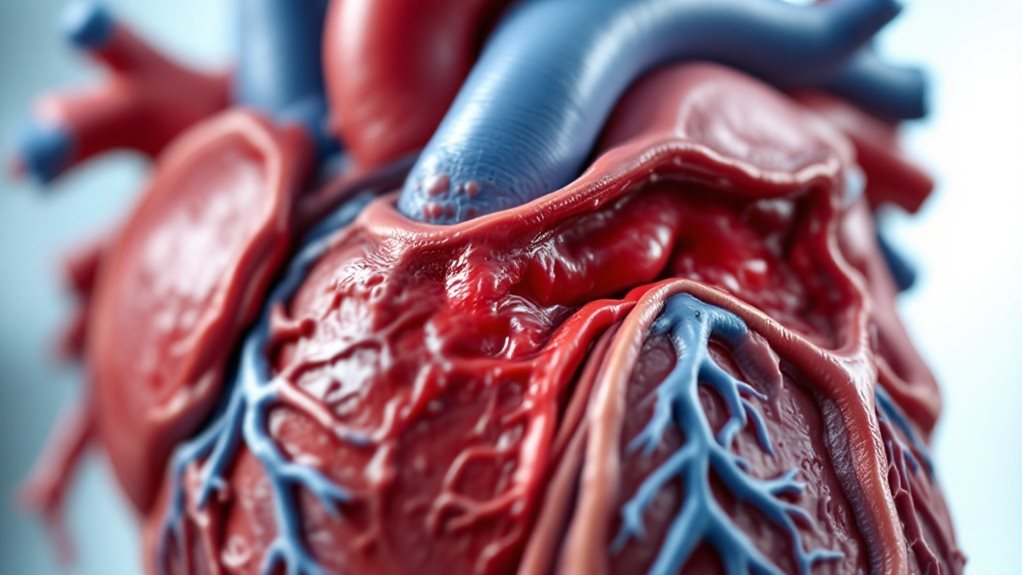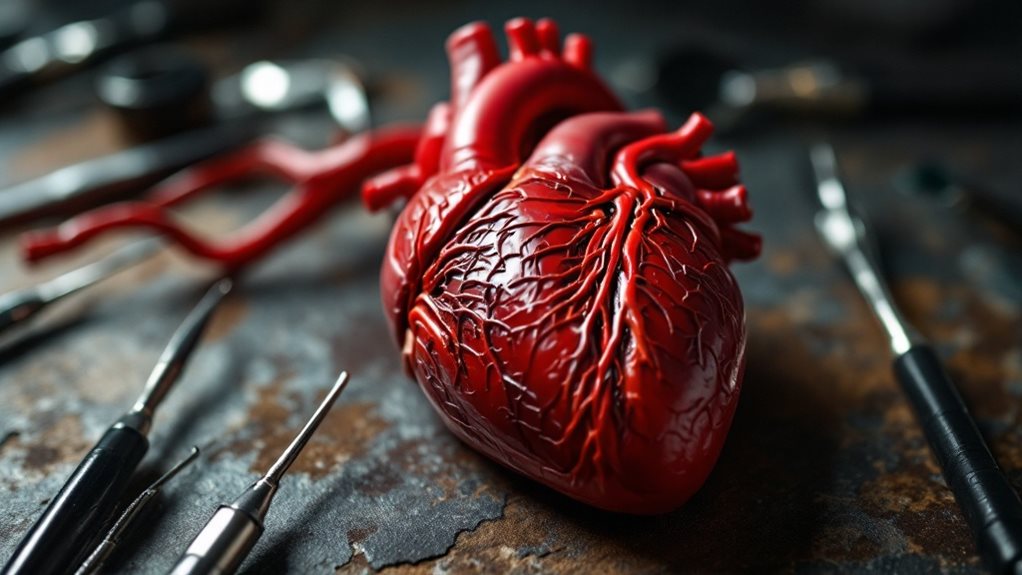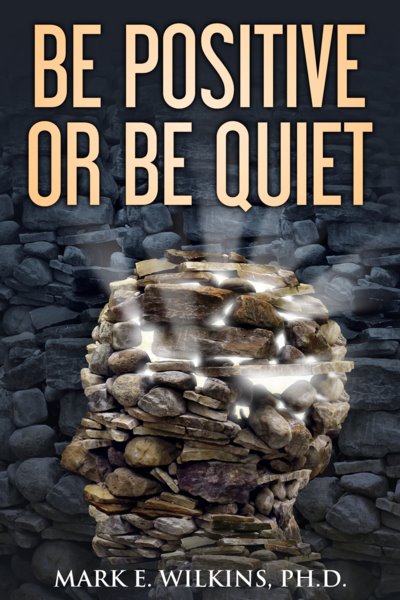
The Widowmaker blockage involves a critical obstruction in your left anterior descending (LAD) artery, essential for supplying blood to the heart muscle. This specific blockage type can drastically impair heart functionality and is often asymptomatic until a severe cardiac event strikes. Given its high mortality rates as a result of abrupt cardiac incidents, identifying signs early through regular diagnostics is paramount. Factors heightening the risk include high cholesterol, hypertension, and smoking, with symptoms typically manifesting as chest pain, shortness of breath, or jaw discomfort. Awareness and early detection could save your life—there’s more to explore on how to effectively manage and prevent this condition.
Key Takeaways
- The Widowmaker blockage affects the left anterior descending (LAD) artery, critical for heart muscle blood supply.
- It can lead to severe heart attacks due to its location and the large area of the heart it supplies.
- Symptoms often remain unnoticed until a major cardiac event occurs, making early detection and regular check-ups vital.
- Treatments include angioplasty to open the blockage and bypass surgery for more complex cases.
- Prevention involves managing risk factors such as high cholesterol, hypertension, and adopting a healthy lifestyle.
Media error: Format(s) not supported or source(s) not found
Download File: https://growth-enrichment.com/wp-content/uploads/2025/01/widow-maker-blockage.mp4?_=1Understanding the Widowmaker Blockage

Understanding the Widowmaker blockage begins with recognizing its important location in the heart’s anatomy. Specifically, it involves the left anterior descending (LAD) artery, which is essential for supplying blood to a large portion of the heart muscle, including the front and main walls. This artery’s blockage can severely impair the heart’s functionality due to the considerable territory it nourishes.
In dissecting the risk factors, it’s imperative you’re aware that lifestyle, genetic predisposition, and existing health conditions play pivotal roles. High cholesterol, hypertension, smoking, diabetes, and a family history of heart disease greatly elevate the risk of developing coronary artery disease, including severe blockages like the Widowmaker.
Diagnostic tests are crucial for detection and management. An Electrocardiogram (ECG) can show changes that suggest a blockage. However, for a direct assessment, a Coronary Angiography remains the gold standard. This procedure involves injecting a contrast dye into the coronary arteries to visualize blockage on X-rays.
Besides, non-invasive tests like a stress test or a Cardiac CT angiography can also provide important information about the health of your coronary arteries.
Understanding these elements is essential for early detection and management. If you’re at risk, regular check-ups and diagnostic tests aren’t just advisable; they’re necessary.
Symptoms of a Heart Attack

Why should you be vigilant about recognizing heart attack symptoms? Early detection is essential to mitigating the severe consequences that can ensue from delayed medical intervention.
The primary symptom to be aware of is chest pain, typically described as a crushing or squeezing sensation that may radiate to other areas such as the arms, neck, jaw, or back. This pain isn’t fleeting; it persists and intensifies, signaling the urgent need for medical attention.
Another significant symptom is jaw discomfort. Often overlooked or misattributed to other causes like dental issues or muscular tension, jaw pain associated with a heart attack usually appears suddenly and feels intense. It’s typically not isolated; you might experience it concurrently with chest pain or other symptoms, forming a pattern that points directly to cardiac distress.
Shortness of breath is also a hallmark symptom, manifesting without the exertion that would normally justify such respiratory difficulty. You might find yourself gasping for air during minimal activity or even at rest. This symptom arises from the heart struggling to pump effectively, leading to reduced oxygen transport to the lungs and throughout the body.
Recognizing these symptoms isn’t just about noting their presence; it’s about understanding their sudden onset and combined occurrence. Each symptom on its own mightn’t suggest a heart attack, but together, they form a significant pattern that demands immediate attention.
Stay alert to these signs. Your timely response could be pivotal in preserving heart function and, ultimately, saving your life.
Immediate Actions and Emergency Response

When symptoms of a heart attack emerge, immediate action is essential to maximize survival chances and mitigate heart damage. You must recognize the urgency of the situation and initiate an emergency response without delay. If you’re alone, dial emergency services immediately, reporting your symptoms accurately.
If someone else is present, instruct them to make the call, ensuring help is on the way as rapidly as possible.
Following the emergency call, if you’re trained, begin administering first aid. It’s important to have the person sit in a slight upright position, easing the strain on the heart while waiting for medical assistance.
Administering aspirin, if not contraindicated, can help slow the clotting action and is often recommended in the acute setting of a heart attack. However, confirm there are no allergies to aspirin and that it’s appropriate for the individual’s health condition.
Monitor essential signs continuously; if the person becomes unresponsive and you’re trained to do so, begin CPR immediately. This could be critical in preventing cardiac arrest from leading to irreversible damage or death.
Always prioritize keeping the person calm, as stress can exacerbate the heart’s workload.
Treatment Options and Procedures

Once emergency services are contacted and initial first aid measures are in place, attention shifts to more detailed medical interventions to manage a widowmaker blockage. The focal point of these interventions is to promptly restore blood flow through the vital artery, minimizing heart damage.
The primary treatments include:
- Angioplasty Techniques: This minimally invasive procedure involves the insertion of a catheter through a small puncture in a peripheral artery. It’s guided to the site of the blockage in your heart. A balloon at the catheter’s tip is inflated to compress the plaque against your artery walls, enhancing blood flow.
- Stent Placement: Following angioplasty, a stent, which is a small wire mesh tube, is often placed in the dilated artery. This stent acts to keep the artery open long-term, preventing re-narrowing and guaranteeing continued blood flow.
- Bypass Surgery: In cases where angioplasty and stenting aren’t viable—perhaps due to the complexity or extent of arterial blockages—coronary artery bypass grafting (CABG) might be recommended. This surgery involves creating a new route for blood to flow to the heart, bypassing the obstructed artery.
- Medication Management: Post-procedure, you’ll likely be prescribed medications to prevent blood clots, lower cholesterol, and manage heart pressure.
Each technique’s application depends on specific factors including the blockage’s severity, your overall health, and the presence of other medical conditions.
It’s essential that you’re closely monitored and that follow-up care is meticulously adhered to, to guarantee the best possible outcomes from these interventions.
Preventive Measures and Lifestyle Changes

To prevent the occurrence of a widowmaker blockage, adopting a heart-healthy lifestyle is essential. This involves a thorough approach encompassing dietary modifications, exercise routines, and stress management. Let’s explore each of these vital areas to understand how you can proactively guard against this severe cardiac event.
Heart-Healthy Lifestyle Components
| Aspect | Strategy | Benefit |
|---|---|---|
| Dietary Changes | Incorporate whole grains, lean proteins, and a high intake of vegetables and fruits. Limit saturated fats and trans fats. | Reduces cholesterol levels, manages blood pressure, and decreases the risk of coronary artery disease. |
| Exercise Routines | Engage in at least 150 minutes of moderate aerobic activity or 75 minutes of vigorous activity per week. | Enhances cardiovascular fitness, aids in weight management, and improves blood circulation. |
| Stress Management | Adopt techniques such as mindfulness, yoga, and regular relaxation practices. | Lowers cortisol levels, reduces blood pressure, and stabilizes heart rate. |
It’s imperative that you’re not only aware of these strategies but actively integrate them into your daily life. Dietary modifications should focus on nutrient density and the avoidance of processed foods high in unhealthy fats and sugars. Consistent exercise routines not only enhance your physical health but also promote endothelial function, essential for maintaining unobstructed coronary arteries. Finally, effective stress management can prevent the physiological strain that exacerbates heart conditions.
Adopting these changes isn’t just about avoiding the widowmaker blockage—it’s about fostering a sustainable, healthy lifestyle that enhances your overall well-being. Remember, it’s the daily choices that shape your health trajectory.
Frequently Asked Questions
Can Genetic Factors Increase Risk of a Widowmaker Blockage?
Yes, genetic factors can indeed increase your risk of a widowmaker blockage.
If you have a familial history of cardiovascular disease or specific inherited conditions, these can predispose you to this severe arterial blockage.
Genes play an important role in determining your cholesterol levels, blood pressure, and other factors that contribute to arterial plaque build-up.
Regular screenings and managing risk factors are essential if you’re genetically predisposed to such conditions.
How Does Stress Contribute to Heart Artery Blockages?
Stress markedly spikes your risk of heart artery blockages by straining your system and skewing stress hormone levels.
Managing stress through techniques like meditation, regular relaxation, and exercise can mitigate this risk.
Prioritizing your emotional health and implementing lifestyle modifications are vital.
Such interventions help in reducing arterial tension and improving overall cardiovascular health, making them essential strategies in the prevention of critical blockages in cardiac arteries.
Can Young People Suffer From a Widowmaker Blockage?
Yes, young people can suffer from a widowmaker blockage. Factors like poor lifestyle choices, such as smoking or a high-fat diet, greatly contribute to early onset of this severe condition.
Be aware of early symptoms like chest pain or breathlessness, which should prompt immediate medical evaluation.
Prioritizing youth heart health through regular exercise and a balanced diet is essential to mitigate risks associated with this potentially fatal artery blockage.
Are There Silent Symptoms of a Widowmaker Blockage?
Even without an overt siren’s cry, the widowmaker blockage can whisper through silent signs.
You might encounter unnoticed symptoms like mild discomfort or fatigue, misleading in their subtlety. These vague indicators often mask the grave threat lurking within.
It’s essential to heed even these gentle hints as potential alarms of a critical condition. Early detection is paramount, as these symptoms can precede more severe, life-threatening manifestations of heart disease.
How Often Should One Screen for Heart Blockages?
You should undergo heart screening based on your individual risk factors and health history.
Typically, an initial risk assessment during routine check-ups will gauge your need for more specific heart screenings.
For preventive measures, adults aged 40 and above or those with risk factors for coronary disease should consider more frequent evaluations.
Advanced screenings like CT calcium scoring are used to detect blockages early, especially if you’re at elevated risk.
Conclusion
To sum up, if you’re grappling with symptoms suggestive of a heart attack, consider them a red alert. The widowmaker, a notorious adversary lurking in the shadows of your heart’s arteries, demands swift and decisive action. Do not hesitate; your heart’s resilience hangs in the balance. Embrace preventive strategies and modify your lifestyle to fortify your heart against this stealthy foe. Remember, each moment counts in turning the tide against this life-threatening blockade.






